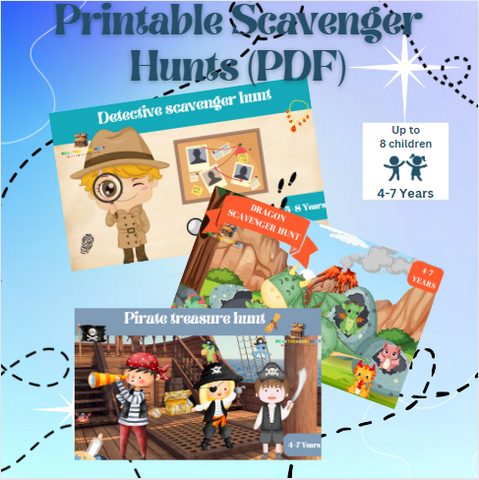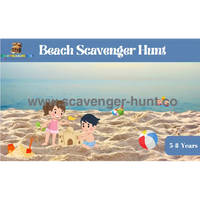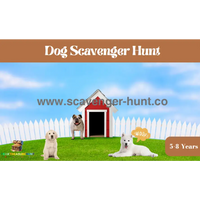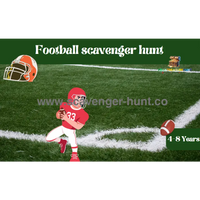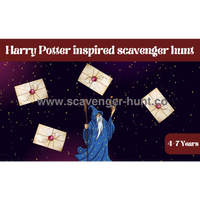👹A Thrilling Monster Quest for Kids
Are you ready for a thrilling monster scavenger hunt? Imagine running through your neighborhood or local park, searching for clues, and discovering hidden monsters around every corner. This fun activity is perfect for kids aged 4 to 12, and it's an excellent way to encourage outdoor play, teamwork, and imagination. Parents, join in on the fun and help your children explore a world of adventure and excitement. In this article, we will guide you through everything you need to know to organize your very own monster scavenger hunt, from planning and preparation to executing the hunt and ensuring everyone has a blast.
Planning Your Monster Scavenger Hunt
Organizing a monster scavenger hunt might seem like a big task, but with a little planning, it can be a breeze. Here are the steps to get started:
Choose a Location
The first step in planning your monster scavenger hunt is selecting the perfect location. You'll need a safe and spacious area where kids can run around freely and explore. Ideal locations include:
-
Parks: Public parks offer wide-open spaces and plenty of hiding spots for clues. They are also usually equipped with playgrounds, which can be incorporated into your hunt.
-
School Grounds: If you have access to a schoolyard, this can be a great option. The familiar environment can make it easier for kids to navigate.
-
Large Backyards: For a more intimate setting, a large backyard can be transformed into a monster hunting ground. This option allows for more control over the environment and the hunt's setup.
When choosing your location, consider the safety of the area. Ensure it's free from hazards like busy roads or bodies of water, and make sure there are plenty of places where you can hide clues and set up challenges.
Set a Date and Time
Next, pick a date and time that works for everyone involved. Weekend afternoons are usually the best choice since most kids are free from school and other activities. Here are some tips for setting the perfect time:
-
Duration: Plan for the hunt to last about an hour or two. This duration is long enough to keep kids engaged but not so long that they become tired or lose interest.
-
Weather: Check the weather forecast in advance. Choose a day when the weather is likely to be clear and comfortable.
-
Nap Schedules: For younger children, consider their nap schedules. Mid-morning or late afternoon can be good times to start, ensuring they are well-rested and energetic.
Create a Theme
Decide on a theme for your monster scavenger hunt to make it more exciting and cohesive. The theme will guide the type of monsters, clues, and decorations you'll use. Here are a few ideas:
-
Friendly Monsters: Use characters like those from "Monsters, Inc." or other friendly monster stories. This theme is great for younger kids who might find scary monsters too frightening.
-
Mythical Creatures: Incorporate creatures like dragons, unicorns, and griffins. This theme adds a magical element to the hunt and can be very engaging for kids who love fantasy stories.
-
Spooky Ghouls: For older kids, a spooky theme with ghosts, goblins, and witches can add an element of thrill. Make sure to keep the level of scariness appropriate for the age group.
Make a Map
A map is a crucial tool for guiding the children through the hunt. Here’s how to create a simple yet effective map:
-
Layout: Sketch the area where the hunt will take place, marking key landmarks like trees, playground equipment, and buildings.
-
Clue Locations: Decide where each clue will be hidden and mark these spots on the map. Number them in the order they should be found to help keep the hunt organized.
-
Decorations: Add some monster-themed decorations to the map to make it more visually appealing. Use bright colors and fun drawings to capture the kids' attention.
Provide each team with a copy of the map to help them navigate the area. This not only adds to the excitement but also ensures that everyone knows the boundaries of the hunt.
Prepare Clues and Challenges
The heart of a monster scavenger hunt lies in the clues and challenges. Here’s how to prepare them:
-
Write Clues: Create clues that lead to the next location. Use rhymes, riddles, and simple puzzles to make the clues engaging. For example, "To find the next clue, look under the swing, where a friendly monster likes to sing."
-
Challenges: Include fun challenges at each clue location. These can be physical activities like jumping jacks, mental tasks like solving a riddle, or creative tasks like drawing a picture of a monster.
-
Variety: Mix up the types of clues and challenges to keep things interesting. Some clues can be straightforward, while others might require more thought or teamwork.
Preparing these elements in advance ensures the hunt runs smoothly and keeps the kids engaged throughout the event.
By following these steps, you'll be well on your way to organizing a fantastic monster scavenger hunt that kids will remember for years to come. From choosing the perfect location to crafting creative clues, a little planning goes a long way in creating an unforgettable adventure.
⬇️⬇️⬇️⬇️DISCOVER OUR MONSTER SCAVENGER HUNT!!⬇️⬇️⬇️⬇️

Crafting Monster Clues and Challenges
Creating engaging clues and challenges is the heart of a successful monster scavenger hunt. This chapter will guide you through the process of designing fun and imaginative tasks that will keep the children excited and motivated as they hunt for hidden monsters.
Write Creative Clues
The clues are essential for guiding the children from one location to the next. Here are some tips for writing effective and engaging clues:
-
Rhyming Riddles: Rhymes make clues more fun and memorable. For example, "To find the next clue, look high and low, near the tree where the flowers grow."
-
Puzzle Pieces: Create puzzles where each clue provides a piece of the puzzle. The children must collect all the pieces to see the full picture, which will guide them to the final destination.
-
Visual Clues: Use pictures or symbols as part of the clues, especially for younger children who may not yet read fluently. For example, a drawing of a swing could indicate the next clue is hidden at the playground swing set.
-
Directional Hints: Include simple directions like “Take ten steps to the right” or “Look behind the big oak tree” to help kids find the next clue.
Incorporate Physical Challenges
Adding physical challenges to the monster scavenger hunt keeps the energy levels high and helps children burn off excess energy. Here are some ideas for incorporating physical tasks:
-
Obstacle Courses: Set up a mini obstacle course with cones, ropes, and hula hoops. The children must complete the course to earn their next clue.
-
Jumping Jacks: At certain locations, have the children perform a set number of jumping jacks or other simple exercises before moving on.
-
Relay Races: Include a relay race segment where children must run a short distance, grab a clue, and return to their team.
Engage Their Minds with Puzzles
Puzzles are a great way to challenge the children’s minds and keep the hunt intellectually stimulating. Here are some examples of mental challenges:
-
Jigsaw Puzzles: Give each team a small jigsaw puzzle to complete at a clue location. Once finished, the completed puzzle reveals the next clue.
-
Riddles: Craft age-appropriate riddles that children must solve to find their next clue. For example, "I have keys but open no locks. I have space but no room. You can enter but not go outside. What am I?" (Answer: A keyboard)
-
Word Searches: Create simple word search puzzles that contain hidden words related to the monster theme. Finding all the words will reveal the next clue.
Add Creative Tasks
Encouraging creativity through tasks makes the hunt more enjoyable and allows children to express themselves. Here are some creative task ideas:
-
Drawing Challenges: Ask the children to draw a picture of the monster they are hunting. Provide them with crayons and paper at a clue location.
-
Monster Dance: Have the children perform a silly "monster dance" before receiving their next clue. This can be a fun and lighthearted way to keep the atmosphere lively.
-
Storytelling: At certain points in the hunt, have the children make up a short story about the monster they are searching for. This can be done in groups to promote teamwork.
Use Monster Facts to Educate
Incorporating educational elements can make the hunt both fun and informative. Here are ways to include monster facts:
-
Fun Facts: Include interesting facts about different types of monsters with each clue. For example, "Did you know that dragons are believed to have been inspired by dinosaur fossils?"
-
History Lessons: Briefly explain the origins of mythical creatures or famous monsters from different cultures. This adds an educational aspect to the hunt.
-
Science Connections: Relate certain monsters to real-life animals or natural phenomena. For example, discuss how the legend of the Kraken might have been inspired by sightings of giant squids.
By combining these elements—creative clues, physical challenges, puzzles, creative tasks, and educational content—you can craft a monster scavenger hunt that is both thrilling and enriching. This variety ensures that all children, regardless of their interests or abilities, will find something to enjoy and engage with during the hunt.
Assembling Your Monster Hunt Kit
To ensure your monster scavenger hunt runs smoothly, you'll need to prepare a few items in advance. Here’s a detailed list of what you’ll need to include in your hunt kit to guarantee a fun and successful event:
Clue Cards
Clue cards are the backbone of your scavenger hunt. Here’s how to prepare them:
-
Writing Clues: Write clear and engaging clues on index cards or printable templates. Make sure each clue leads logically to the next location.
-
Protecting Clues: Place the cards in envelopes or plastic bags to protect them from the weather. You can even decorate the envelopes with monster stickers or drawings to add to the theme.
-
Numbering Clues: Number each clue to keep them in order. This helps both the organizers and participants keep track of the hunt’s progress.
Monster Costumes
Costumes and props can greatly enhance the fun of the scavenger hunt:
-
Simple Masks: Provide simple monster masks that children can wear. These can be bought or made using templates and craft supplies.
-
Props: Include props like monster hats, claws, or tails. These can be worn by participants or used as decorations at each clue location.
-
Role-Playing: Encourage children to get into character as they search for clues. This adds an imaginative element to the hunt.
Treasure Chest
The final destination of the hunt should be a treasure chest filled with rewards:
-
Contents: Fill the treasure chest with goodies such as stickers, small toys, candy, or monster-themed prizes.
-
Decorating the Chest: Decorate the treasure chest to match the monster theme. You can use paint, stickers, or even wrap it in themed paper.
-
Location: Hide the treasure chest at the final clue location. Make sure it’s well-hidden but accessible.
Map Copies
Providing each team with a map helps them navigate the hunt area:
-
Drawing the Map: Create a simple map of the hunt area, marking key landmarks and clue locations.
-
Copying the Map: Make enough copies for each team. Consider laminating them for durability.
-
Instructions: Include brief instructions on how to use the map, emphasizing the importance of staying within the designated boundaries.
Safety Supplies
Safety is a top priority when organizing a monster scavenger hunt:
-
First-Aid Kit: Pack a basic first-aid kit with bandages, antiseptic wipes, and other essentials.
-
Water and Snacks: Provide water bottles and healthy snacks to keep the participants hydrated and energized.
-
Emergency Contact Information: Have a list of emergency contact numbers for all participants. Ensure that all supervisors have a copy.
By assembling these items in advance, you can ensure that your monster scavenger hunt runs smoothly and that all participants have a safe and enjoyable experience. Preparing a comprehensive hunt kit is a crucial step in creating a memorable adventure for the children.
Executing the Monster Scavenger Hunt
On the day of the monster scavenger hunt, follow these steps to ensure a fun and safe experience for everyone:
Brief the Participants
Before starting the hunt, gather all the children and provide a clear explanation of the rules and objectives:
-
Rules: Explain the basic rules, such as staying within the hunt area, following the clues in order, and working as a team.
-
Safety Guidelines: Emphasize the importance of safety, including staying with their group and listening to their team leader.
-
Objective: Outline the goal of the hunt—finding all the clues to reach the final treasure.
Divide into Teams
Organize the children into small groups to promote teamwork and ensure everyone is engaged:
-
Team Size: Ideally, each team should have about 4-6 children, along with an adult supervisor.
-
Team Leaders: Assign an adult or older child as the team leader to help guide the group and keep them on track.
-
Team Names: Encourage teams to come up with fun monster-themed names to build team spirit.
Start the Hunt
Hand out the first clue and let the adventure begin:
-
Distribution: Give each team their first clue and a map. Make sure they understand how to use the map to navigate.
-
Starting Signal: Use a fun starting signal, like a monster roar or a countdown, to kick off the hunt.
Monitor Progress
Keep an eye on the teams to ensure they are safe and making progress:
-
Roaming Supervisors: Have a few adults move around the hunt area to check on teams and offer assistance if needed.
-
Hints: Be prepared to give hints if a team gets stuck on a particularly challenging clue.
-
Encouragement: Cheer on the teams and celebrate their successes to keep morale high.
Celebrate the Finish
When the teams find the final treasure, celebrate their achievement with a small party:
-
Treasure Reveal: Gather all the teams around the final location for the big reveal of the treasure chest.
-
Prize Distribution: Hand out the prizes and let each child pick a reward from the treasure chest.
-
Share Stories: Encourage the children to share their favorite moments from the hunt and what they enjoyed most.
Executing the monster scavenger hunt with these steps ensures that the event is organized, safe, and fun for all participants. It allows for a structured yet adventurous experience that will leave the children excited and eager for more.
⬇️⬇️⬇️⬇️DISCOVER OUR MONSTER SCAVENGER HUNT!!⬇️⬇️⬇️⬇️

Reflecting on the Monster Scavenger Hunt Experience
After the monster scavenger hunt is over, take some time to reflect on the experience with your children and other participants:
Discuss the Adventure
Talk with the children about what they enjoyed most and what they learned:
-
Favorite Moments: Ask each child to share their favorite part of the hunt. This helps reinforce the positive experiences.
-
Learning Points: Discuss any new facts or skills they picked up during the hunt, such as teamwork, problem-solving, or interesting monster trivia.
Collect Feedback
Gather feedback from both the kids and the parents to improve future hunts:
-
Surveys: Create a simple feedback form for parents and children to fill out. Ask about what worked well and what could be improved.
-
Group Discussion: Hold a brief discussion with the children to get their immediate reactions and suggestions for next time.
Share Photos and Stories
If you took photos during the hunt, share them with the participants:
-
Photo Album: Create a photo album or digital slideshow to share with the families. This can be a wonderful keepsake.
-
Storytelling: Encourage the children to write or draw about their adventure. This can be shared with their classmates or displayed at home.
Plan the Next Hunt
Based on the feedback, start planning the next monster scavenger hunt:
-
New Ideas: Incorporate new themes and ideas suggested by the participants to keep things fresh and exciting.
-
Improved Clues and Challenges: Use the feedback to refine the clues and challenges, making them more engaging and suitable for the age group.
Thank Participants
Show your appreciation to everyone who participated and helped organize the event:
-
Thank-You Notes: Send thank-you notes or emails to the participants and their families, expressing your gratitude for their involvement.
-
Volunteer Recognition: Acknowledge the efforts of any volunteers who helped with planning and execution. Consider giving them a small token of appreciation.
Reflecting on the monster scavenger hunt experience helps reinforce the positive aspects and provides valuable insights for future events. It also ensures that everyone involved feels appreciated and eager to participate in future adventures.
Frequently Asked Questions
1. What is a monster scavenger hunt?
A monster scavenger hunt is an interactive game where participants search for clues and complete challenges to find hidden monsters. It's a fun activity that promotes teamwork, creativity, and outdoor play.
2. How do you organize a monster scavenger hunt?
To organize a monster scavenger hunt, choose a safe location, set a date and time, create a theme, make a map, and prepare clues and challenges. Assemble a hunt kit with clue cards, monster costumes, a treasure chest, map copies, and safety supplies.
3. What age group is suitable for a monster scavenger hunt?
A monster scavenger hunt is ideal for children aged 4 to 12. The clues and challenges can be tailored to suit the age group and skill level of the participants.
4. What should be included in the monster scavenger hunt kit?
The kit should include clue cards, monster costumes, a treasure chest with prizes, map copies, and safety supplies like a first-aid kit, water bottles, and snacks.
5. How can you ensure the safety of participants during a monster scavenger hunt?
Ensure safety by choosing a secure location, briefing participants on rules, dividing them into supervised teams, monitoring progress, and providing safety supplies. Emphasize the importance of staying together and following the boundaries.
Conclusion
A monster scavenger hunt is a fantastic way to engage children in active play, spark their imagination, and encourage teamwork. By following the steps outlined in this guide, you can create a memorable experience that kids will talk about for days. From planning the perfect location and crafting creative clues to assembling a comprehensive hunt kit and executing the hunt, every detail plays a crucial role in ensuring the event's success.
The excitement of the hunt lies in the thrill of finding each clue, solving fun challenges, and ultimately discovering the hidden treasure. Along the way, children develop important skills such as problem-solving, cooperation, and creativity. Whether it’s through drawing a picture of their favorite monster, racing through an obstacle course, or piecing together a puzzle, each activity adds to the adventure and learning experience.
Parents and organizers also play a vital role in making the hunt safe and enjoyable. By preparing in advance, monitoring progress, and celebrating the children's achievements, you create a supportive environment that enhances the overall fun. The shared joy and camaraderie fostered during the hunt build lasting memories and strengthen bonds among the participants.
In conclusion, a monster scavenger hunt promises endless fun and adventure for everyone involved. It's an event that brings together families and friends, creating opportunities for laughter, learning, and memorable moments. So, gather your supplies, rally the kids, and embark on a monstrous adventure that will be remembered for years to come. Whether it's a birthday party, a school event, or a weekend activity, a monster scavenger hunt is sure to be a hit, leaving everyone eagerly anticipating the next adventure.
⬇️⬇️⬇️⬇️DISCOVER OUR MONSTER SCAVENGER HUNT!!⬇️⬇️⬇️⬇️

Discover our Complete Scavenger Hunts Collection.

